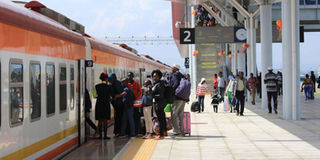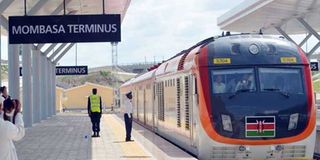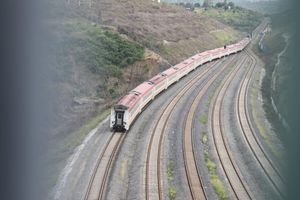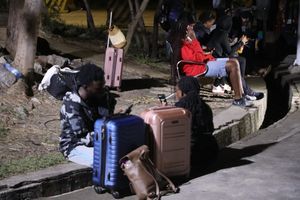
Passengers queue to board the Madaraka Express SGR train in Nairobi.
Passenger traffic aboard the Standard Gauge Railway (SRG) dropped to 529,591 between January and March, marking a dip for the third consecutive year even as high fares helped to negate the impact of the fall in ticket sales.
Analysis of official data shows that this was a drop from the 531,673 passengers in the same period of last year and 597,506 from January and March of 2023.
But revenues grew in the period under review to hit Sh936.29 million, a 6.2 percent rise from Sh880.82 million from January to March of last year, underscoring the impact of a decision by the Kenya Railways Corporation (KRC) to double fares effective January this year.
The data shows that the last time that passenger numbers on the trains were lower than the period January to March this year was in 2022, when 518,780 tickets were sold, raising revenues of Sh569.27 million.
KRC doubled fares for the Nairobi to Mombasa trains from January 1 this year, with first-class tickets jumping to Sh4,500 from Sh3,000 while those for economy class rose to Sh1,500 from Sh1,000.

A new train at the Nairobi terminus on May 29, 2017.
The decision to raise fares, which KRC attributed to rising fuel costs, has dampened the trains attraction to Kenyans amid tough economic times. The new fares apply to both the express and inter-county routes between Kenya’s two biggest cities.
High fares, which drew uproar from Kenyans have been critical in helping the SGR to drive revenues as doubts mount on when the train will break even and ease reliance on the Exchequer for operational cash and repaying the Chinese loans.
For example, in 2021 the Treasury illegally used Sh18.1 billion collected from motorists via the Petroleum Development Levy fund to pay the Chinese firm operating the trains.
Withdrawal of the billions to pay Africa Star Railway Operation Company brought to the fore the burden that the SGR has placed on taxpayers due to its inability to break even.

Madaraka Express arrives at the Mombasa Terminus in Miritini. Kenya Railways downplayed fears that Kenyan workers have not been fully trained to take over SGR operations.
Besides the high operational costs, the trains (passenger and cargo) have also not been able to make enough money that can partly help repay the multi-billion loans tapped from China to fund the project.
Construction of the modern rail and purchase of the coaches and locomotives for passengers and cargo was funded by a $5.08 billion (Sh656.28 billion at current exchange rates) Chinese loan whose repayment started in 2020 following the end of a five-year repayment grace period.
Kenya will heavily rely on China for funding of the Sh502.9 billion project to extend the SGR from Naivasha to Kisumu and the border town of Malaba.
The extension is key to ensuring a seamless rail connection between Kenya and Uganda and boosting the movement of goods and people between the two countries.





